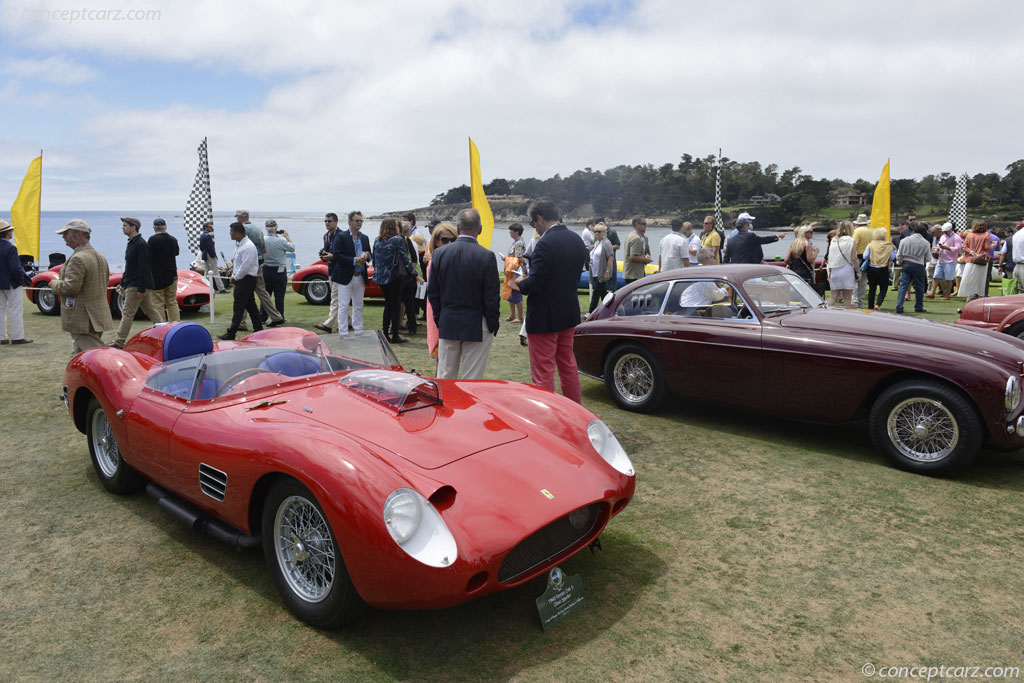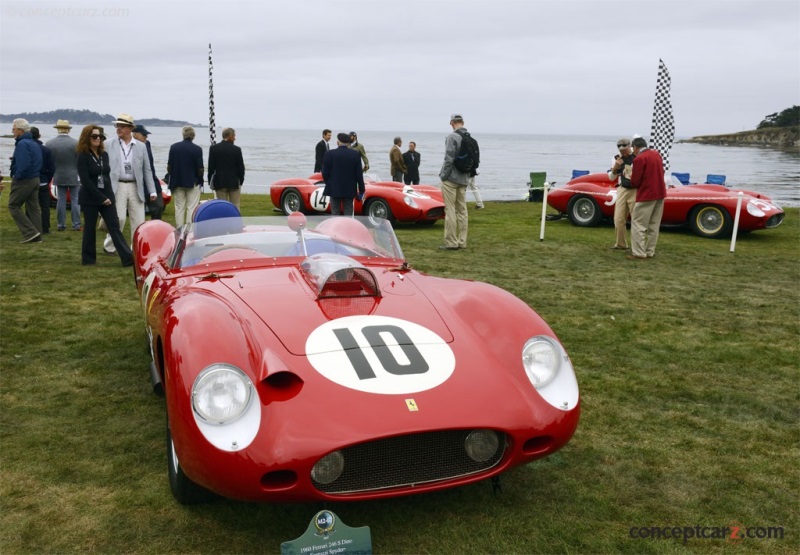Enzo Ferrari began producing race cars in 1929 and sponsored drivers and cars. In 1947, the company began building street legal machines. The prancing horse was introduced on company stationery in 1929. The idea was formed when Enzo met a Countess whose son was an Italian Air Force ace in World War I. He had decorated his airplane with dancing horse. Enzo decided to color the horse black which is the color used by the Count's squadron as a sign of grief after he was killed in action. The yellow background is the color of Enzo's birthplace, Modena.
Sports Racer by Fantuzzi
Chassis #: 0778
View info and historyFerrari raced their 246 F1 cars for three seasons, from 1958 to 1960. Over that time, the cars were continually developed. They were piloted by some of the greatest names in racing, including Phil Hill, Wolfgang von Trips, Richie Ginther, Dan Gurney, Mike Hawthorne, Peter Collins, Tony Brooks, Cliff Allison and Jean Behra. In the 1958 and 1959 Constructors Championship, the Ferrari 246 F1 cars were driven to 2nd place.The Dino V6 engine, which had been designed for the 1958 season, had been named in memory of Alfredo 'Dino' Ferrari and had been designed (mostly) by engineer Vittorio Jano. The engine had a 65 degree angle and was given twin overhead camshafts. It made its racing debut in 1.5 liter Formula 2 guise, but was soon enlarged to better compete with the F1 competition. In common Ferrari tradition, it was not long before the Formula 1 engine found its way into a sportscar. Less than a year after its racing debut, the Dino engine had been installed into a sports racer. By this point in history, the traditional Ferrari naming practice (based on unitary displacement) had been abandoned; the new nomenclature had the first two figures indicate the displacement while the third number represented the number of cylinders. 
Sports Racer by Fantuzzi
Chassis #: 0778
View info and historyThe Ferrari 206 S Sports Racer made its debut with Peter Collins behind the wheel at the 1958 Sussex Trophy. The 206 S made several racing appearances throughout the year, along with a three liter engined 296 S, leading to rumors that the Ferrari racing program may eventually replace their V12 racers with the smaller Dino V6 engines. At the end of the season, Enzo Ferrari concluded that the Dino engine was too complex and not fast enough to replace the 250 TRs in the Works program. By the end of 1959, a total of three examples of the Ferrari 246 Dino were built, all wearing Fantuzzi-built bodies. They had similar styling to the 250 Testa Rossa cars of the same era. They made their debut in January of 1960 at the Buenos Aires 100 km during the Temporada Argentina in the hands of Scarfiotti and Gonzalez. Two examples also competed in the Targa Florio, coming in second and fourth respectively. The Dino 246 S cars would enjoy extensive competition by privateers, however the official Ferrari Works drivers only fielded the 250 Testa Rossa.
by Daniel Vaughan | Sep 2014

Sports Racer by Fantuzzi
Chassis #: 0778
View info and history

Sports Racer by Fantuzzi
Chassis #: 0778
View info and history
by Daniel Vaughan | Sep 2014
1960 Ferrari 246 S Dino Vehicle Profiles
Recent Vehicle Additions
Related Automotive News

Just Sold! Gooding & Company Proudly Announces the Recent Private Sale of Racing Veteran 0704 TR, the Only Unrestored Ferrari 250 Testa Rossa in Existence
The collector car market leader recently brokered the private sale of the sole unrestored Ferrari 250 Testa Rossa extant. The overall winner of the 1958 12 Hours of Sebring, 0704 TR is recognized as one of the most significant racing Ferraris of all...

High Efficiency Motors: 1958 Formula One Season
C.T. Tommy Atkins would start out his career as a motorcycle racer riding Douglas motorcycles in the early 1930s. By the time the mid-to-late 50s rolled around, Atkins had moved on from racing, but not very far. Perhaps feeling a need to support up-and-coming...
1958 12 Hours of Sebring: Collins and Hill Escort a Red-Head Home to Victory
In a matter of months Peter Collins would lay dying of wounds received in a violent crash at the Nurburgring during the German Grand Prix. While many would be holding their breaths and facing the cold-hard truth of another motor racing death, there would...

1959 12 Hours of Sebring: 12 Hours to Success
In 1961, Richie Ginther would join Giancarlo Baghetti, Willy Mairesse and Wolfgang von Trips to come away with a 2nd place overall finish in the 12 Hours of Sebring. Completing 208 laps, the Ferrari 250 Testa Rossa would finish two laps behind eventual...

1958 German Grand Prix: So Close Never Felt So Good!
On the 19th of July, at the 11th RAC British Grand Prix, Roy Salvadori would climb to the 3rd step on the podium. It would be the greatest result of his career in Formula One and it would be a most exuberant moment for the man from Dovercourt joining...














